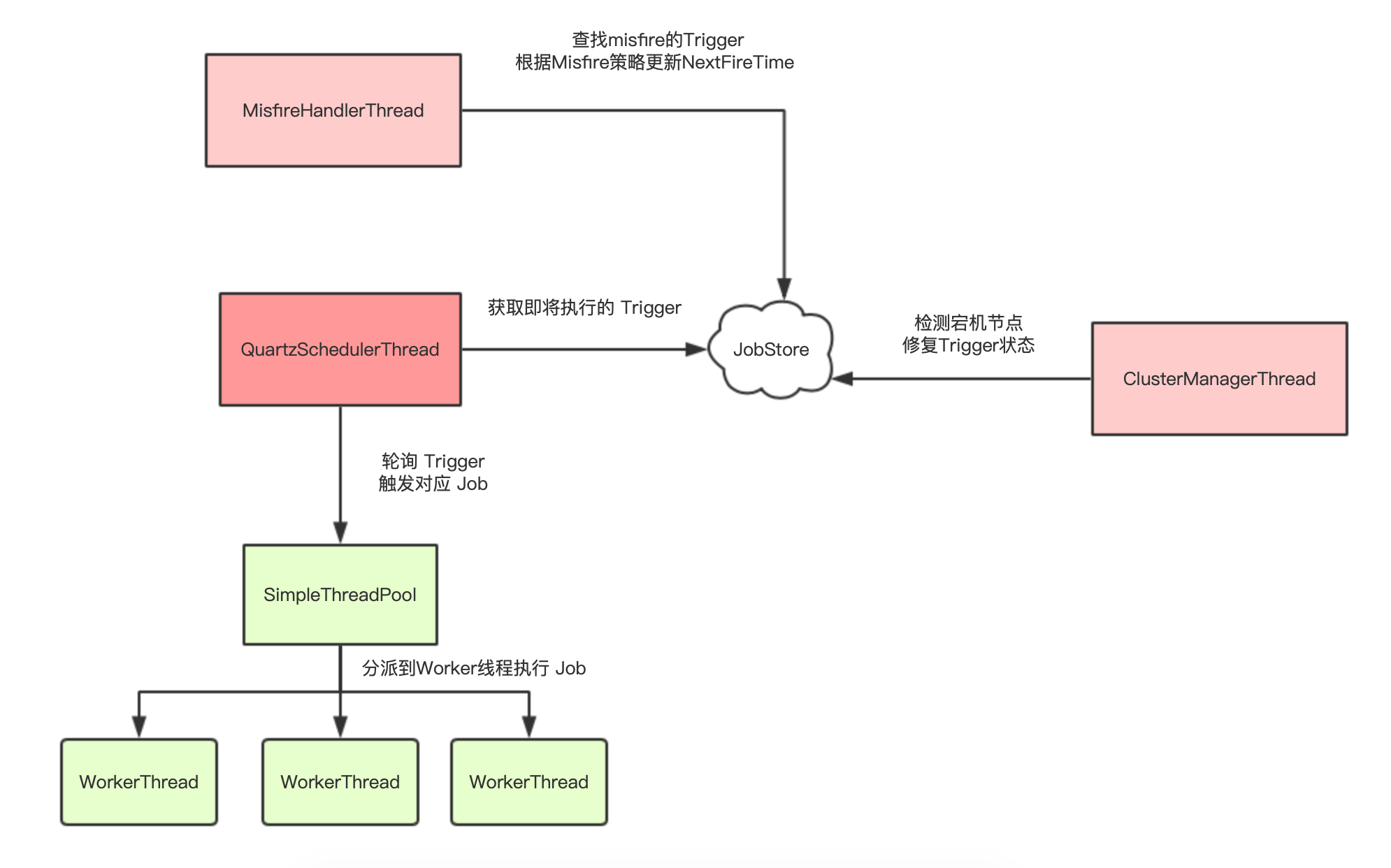1 Quartz 线程
Quartz 有两类线程,调度线程(红) 和 执行线程(绿),如图:

2 QuartzSchedulerThread 分析
QuartzSchedulerThread 为Quartz核心线程,负责任务的调度,读取用户设定的触发器并分配线程,使触发器能够按照预定时间执行。
2.1 执行步骤说明
- 循环判断调度是否应该停止,如果应该停止则清空资源结束调度
- 循环判断调度是否应该暂停,如果应该暂停则,则调用wait阻塞本线程,直到被外部唤醒
- (被唤醒后)从线程池中查询可用的任务执行线程,若线程池中暂无可用线程,则阻塞本线程,直到获取至少一个可用线程
- 根据一定规则从任务存储区域(JobStore)中找出马上要执行的一批触发器
- 配置参数 idleWaitTime,默认为30000,即在当前时间后 30s 内即将被触发执行的触发器就会被取出
- 配置参数 misfireThreshold,默认为60000,即在当前时间的 60s 之前本应执行但尚未执行的触发器不被认为是延迟触发,也会取出。更早之前的由 MisfireHandlerThread 按 Misfire 策略处理。
- 配置参数 batchTriggerAcquisitionMaxCount,默认为1,即一次拉取的批次数量为【 Math.min(该值, 可用线程数) = 1】
- 当该值大于1时,在集群环境下,需确保 acquireTriggersWithinLock 为true,避免多节点同时拉取到相同的Trigger造成重复执行
- 配置参数 batchTriggerAcquisitionFireAheadTimeWindow,默认0,即拉取时,只取相差时间为0ms的Trigger。调大该值,可以让两个执行时间距离较近的触发器同时被取出执行
- 例如:有两个触发器分别是10:00:00和10:00:05执行,此时配置为:batchTriggerAcquisitionFireAheadTimeWindow = 5000,batchTriggerAcquisitionMaxCount = 2,且拥有足够的线程时,这两个触发器就有可能会在预定时间10:00:00被同时执行
- 如果在第4步没有发现需要执行的触发器,该线程将阻塞一段时间(23~30s 随机),随后返回第1步
- 取出的触发器将在内存中等待被执行,但在等待执行的过程中,外部环境也可能修改触发器从而影响触发的时间。所以线程会阻塞到预定将被触发的时间,若阻塞未被打断,则执行,若触发受到外部环境影响,将根据一定的条件判断是否重新取出一批触发器,如果是,则抛弃现有的触发器,回到第1步
- 执行到第6步结束后,程序根据触发器取出对应的任务(job)、记录触发器的触发信息,并调整触发器下一次触发的时间,使触发器在下一次触发时能被取出
- 执行所有取出的触发器
- 执行完所有的触发任务后,返回第1步,重新取出下一批触发器
2.2 源码分析:
@Override
public void run() {
int acquiresFailed = 0;
// 1. 循环判断调度是否应该停止,如果应该停止则清空资源结束调度
while (!halted.get()) {
try {
synchronized (sigLock) {
// 2. 循环判断调度是否应该暂停,如果应该暂停则,则调用wait阻塞本线程,直到被外部唤醒
while (paused && !halted.get()) {
try {
// wait until togglePause(false) is called...
sigLock.wait(1000L);
} catch (InterruptedException ignore) {
}
// reset failure counter when paused, so that we don't
// wait again after unpausing
acquiresFailed = 0;
}
if (halted.get()) {
break;
}
}
// 在前几次的循环中如果触发器的读取出现问题, 则可能是数据库重启一类的原因引发的故障
if (acquiresFailed > 1) {
try {
long delay = computeDelayForRepeatedErrors(qsRsrcs.getJobStore(), acquiresFailed);
Thread.sleep(delay);
} catch (Exception ignore) {
}
}
// 3. 从线程池中查询可用的任务执行线程,若线程池中暂无可用线程,则阻塞本线程,直到获取至少一个可用线程
int availThreadCount = qsRsrcs.getThreadPool().blockForAvailableThreads();
if(availThreadCount > 0) { // will always be true, due to semantics of blockForAvailableThreads...
List<OperableTrigger> triggers;
long now = System.currentTimeMillis();
clearSignaledSchedulingChange();
try {
// 4. 根据一定规则从任务存储区域(JobStore:可以是内存或数据库),中找出马上要执行的一批触发器
triggers = qsRsrcs.getJobStore().acquireNextTriggers(
now + idleWaitTime, Math.min(availThreadCount, qsRsrcs.getMaxBatchSize()), qsRsrcs.getBatchTimeWindow());
acquiresFailed = 0;
if (log.isDebugEnabled())
log.debug("batch acquisition of " + (triggers == null ? 0 : triggers.size()) + " triggers");
} catch (JobPersistenceException jpe) {
if (acquiresFailed == 0) {
qs.notifySchedulerListenersError(
"An error occurred while scanning for the next triggers to fire.",
jpe);
}
if (acquiresFailed < Integer.MAX_VALUE)
acquiresFailed++;
continue;
} catch (RuntimeException e) {
if (acquiresFailed == 0) {
getLog().error("quartzSchedulerThreadLoop: RuntimeException "
+e.getMessage(), e);
}
if (acquiresFailed < Integer.MAX_VALUE)
acquiresFailed++;
continue;
}
if (triggers != null && !triggers.isEmpty()) {
now = System.currentTimeMillis();
long triggerTime = triggers.get(0).getNextFireTime().getTime();
long timeUntilTrigger = triggerTime - now;
while(timeUntilTrigger > 2) {
// 6. 在该while循环体中,被取出的触发器会阻塞等待到预定时间被触发
// 这里用了阻塞,因为当外部环境对触发器做了调整或者新增时,会对线程进行唤醒
// 在阻塞被唤醒后,会有相关的逻辑判断是否应该重新取出触发器来执行
// 比如当前时间是10:00:00,在上述逻辑中已经取出了10:00:05需要执行的触发器
// 此时如果新增了一个10:00:03的触发器,则可能需要丢弃10:00:05的,再取出10:00:03的
synchronized (sigLock) {
if (halted.get()) {
break;
}
// 判断在此过程中是否有新增的并且触发时间更早的Trigger
// 但是此处有个权衡,为了一个新增的的Trigger而丢弃当前已获取的是否值得?
// 丢弃当前获取的Trigger并重新获取需要花费一定的时间,时间的长短与JobStore的实现有关。
// 所以此处做了主观判断,如果使用的是数据库存储,查询时间假定为70ms,内存存储假定为7ms
// 如果当前时间距已获得的第一个Trigger触发时间小于查询时间,则认为丢弃是不合算的。
if (!isCandidateNewTimeEarlierWithinReason(triggerTime, false)) {
try {
// we could have blocked a long while
// on 'synchronize', so we must recompute
now = System.currentTimeMillis();
timeUntilTrigger = triggerTime - now;
if(timeUntilTrigger >= 1)
sigLock.wait(timeUntilTrigger);
} catch (InterruptedException ignore) {
}
}
}
if(releaseIfScheduleChangedSignificantly(triggers, triggerTime)) {
break;
}
now = System.currentTimeMillis();
timeUntilTrigger = triggerTime - now;
}
// this happens if releaseIfScheduleChangedSignificantly decided to release triggers
if(triggers.isEmpty())
continue;
// set triggers to 'executing'
List<TriggerFiredResult> bndles = new ArrayList<TriggerFiredResult>();
boolean goAhead = true;
synchronized(sigLock) {
goAhead = !halted.get();
}
if(goAhead) {
try {
// 7. 执行到第6步结束后,程序根据触发器取出对应的任务(job)、记录触发器的触发信息,并调整触发器下一次触发的时间,使触发器在下一次触发时能被取出
// triggersFired方法主要有几个作用:
// a. 取出触发器对应应执行的任务
// b. 记录触发器的执行,修改触发器的状态,如果对应的任务是StatefulJob,则阻塞其他触发器
// c. 调整触发器下次执行的时间
List<TriggerFiredResult> res = qsRsrcs.getJobStore().triggersFired(triggers);
if(res != null)
bndles = res;
} catch (SchedulerException se) {
qs.notifySchedulerListenersError(
"An error occurred while firing triggers '"
+ triggers + "'", se);
//QTZ-179 : a problem occurred interacting with the triggers from the db
//we release them and loop again
for (int i = 0; i < triggers.size(); i++) {
qsRsrcs.getJobStore().releaseAcquiredTrigger(triggers.get(i));
}
continue;
}
}
// 8. 执行所有取出的触发器
for (int i = 0; i < bndles.size(); i++) {
TriggerFiredResult result = bndles.get(i);
TriggerFiredBundle bndle = result.getTriggerFiredBundle();
Exception exception = result.getException();
if (exception instanceof RuntimeException) {
getLog().error("RuntimeException while firing trigger " + triggers.get(i), exception);
qsRsrcs.getJobStore().releaseAcquiredTrigger(triggers.get(i));
continue;
}
// it's possible to get 'null' if the triggers was paused,
// blocked, or other similar occurrences that prevent it being
// fired at this time... or if the scheduler was shutdown (halted)
if (bndle == null) {
qsRsrcs.getJobStore().releaseAcquiredTrigger(triggers.get(i));
continue;
}
JobRunShell shell = null;
try {
shell = qsRsrcs.getJobRunShellFactory().createJobRunShell(bndle);
shell.initialize(qs);
} catch (SchedulerException se) {
qsRsrcs.getJobStore().triggeredJobComplete(triggers.get(i), bndle.getJobDetail(), CompletedExecutionInstruction.SET_ALL_JOB_TRIGGERS_ERROR);
continue;
}
if (qsRsrcs.getThreadPool().runInThread(shell) == false) {
// this case should never happen, as it is indicative of the
// scheduler being shutdown or a bug in the thread pool or
// a thread pool being used concurrently - which the docs
// say not to do...
getLog().error("ThreadPool.runInThread() return false!");
qsRsrcs.getJobStore().triggeredJobComplete(triggers.get(i), bndle.getJobDetail(), CompletedExecutionInstruction.SET_ALL_JOB_TRIGGERS_ERROR);
}
}
// 9. 执行完所有的触发任务后,返回第1步,重新取出下一批触发器
continue; // while (!halted)
}
} else { // if(availThreadCount > 0)
// should never happen, if threadPool.blockForAvailableThreads() follows contract
continue; // while (!halted)
}
// 5. 如果在第4步没有发现需要执行的触发器,该线程将阻塞一段随机时间,随后返回第1步
long now = System.currentTimeMillis();
long waitTime = now + getRandomizedIdleWaitTime();
long timeUntilContinue = waitTime - now;
synchronized(sigLock) {
try {
if(!halted.get()) {
// QTZ-336 A job might have been completed in the mean time and we might have
// missed the scheduled changed signal by not waiting for the notify() yet
// Check that before waiting for too long in case this very job needs to be
// scheduled very soon
if (!isScheduleChanged()) {
sigLock.wait(timeUntilContinue);
}
}
} catch (InterruptedException ignore) {
}
}
} catch(RuntimeException re) {
getLog().error("Runtime error occurred in main trigger firing loop.", re);
}
} // while (!halted)
// drop references to scheduler stuff to aid garbage collection...
qs = null;
qsRsrcs = null;
}
2.3 流程图

根据规则取出一批触发器的规则说明:
-
配置参数 idleWaitTime,默认为30000,即在当前时间后 30s 内即将被触发执行的触发器就会被取出
-
配置参数 misfireThreshold,默认为60000,即在当前时间的 60s 之前本应执行但尚未执行的触发器不被认为是延迟触发,也会取出。更早之前的由 MisfireHandlerThread 按 Misfire 策略处理。
-
配置参数 batchTriggerAcquisitionMaxCount,默认为1,即一次拉取的批次数量为【 Math.min(该值, 可用线程数) = 1】;当该值大于1时,在集群环境下,需确保 acquireTriggersWithinLock 为true,避免多节点同时拉取到相同的Trigger造成重复执行
-
配置参数 batchTriggerAcquisitionFireAheadTimeWindow,默认0,即拉取时,只取相差时间为0ms的Trigger。调大该值,可以让两个执行时间距离较近的触发器同时被取出执行。例如:有两个触发器分别是10:00:00和10:00:05执行,此时配置为:batchTriggerAcquisitionFireAheadTimeWindow = 5000,batchTriggerAcquisitionMaxCount = 2,且拥有足够的线程时,这两个触发器就有可能会在预定时间10:00:00被同时执行
来源:oschina
链接:https://my.oschina.net/pengranxiang/blog/4313732